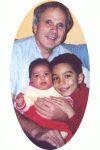One of my strategies for learning Chinese is to read Tintin and children's books in Chinese, and look up the words that I don't know, while I'm reading. That's a lot harder than you might think. It isn't like using a French-English where you can find the word in alphabetical order. A Chinese-English dictionary is in alphabetical order of the Pinyin form of the Chinese, which you can only guess if you already know how the word is pronounced. Chinese writing is composed of pictorial characters like Egyptian hieroglyphics. Each character is a syllable, and you can't guess how it's pronounced from the way it looks.
For example, one character is a box with a line going down through the middle. The Pinyin form is "zhong" which sounds almost like "jong," only you curl your tongue way back for the "jong" instead of putting the tip just above your teeth. Now if I didn't know that already, I would not be able to guess that the Pinyin for a box with a line going down through the middle is "zhong," and I wouldn't know where to look in the Chinese section of the dictionary to find it.
Chinese-English dictionaries have stroke indexes, where you can find a character by its shape, with the Pinyin form next to it. Then you can look it up in the main part of the dictionary. I was just starting to learn that when someone offered me an electronic dictionary. Unfortunately electronic dictionaries don't use the same stroke index system that the paper dictionary uses. There's a graphical input method for traditional Chinese, one for simplified Chinese, and another one that works for both.
One system is called Wubi, abbreviated "WB," one is called "Cangjie," abbreviated "CJ," and the other is called "CKC," abbreviated "ZH." Darned if I know why!
Monday, September 15, 2008
Subscribe to:
Post Comments (Atom)

No comments:
Post a Comment